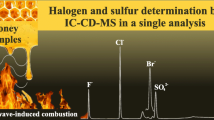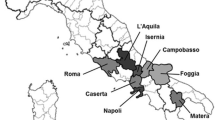Abstract
The elemental composition of honey is correlated with the botanical provenience of nectar, pollen, and honeydew that are collected and ripened by bees. In addition to this, the geographical origin related to the locality of an apiary, the soil composition, and climatic conditions may contribute to the origin of elements in honey. The environmental pollution or other anthropogenic processes and activities also have an effect on the quality and the safety of honey since they may be accompanying sources that lead to its contamination and the presence of various trace elements (Cd, Cr, Cu, Fe, Ni, Pb, and Zn). This review article covers the literature devoted to the analysis of honey carried out by the most popular and commonly utilized flame atomic absorption and emission spectrometry, which was published from 1999 to 2011. Various aspects of such analysis are treated in detail, including ways of the sample preparation, the calibration, and the quality assurance of results. In addition, methods and results related to the fractionation analysis of elements in honey by means of chromatographic and non-chromatographic approaches are described.



Similar content being viewed by others
References
Achudume AC, Nwafor BN (2010) The ecological assessment of metals in local brands of honey in Southwest Nigeria. Afr J Agric Res 5:2608–2610
Antonescu C, Mateescu C (2001) Environmental pollution and its effects on honey quality. Roum Biotechnol Lett 6:371–379
Baroni MV, Arrua C, Nores ML, Faye P, Diaz MP, Chiabrando GA, Wunderlin DA (2009) Composition of honey from Cordoba (Argentina). Assessment of North/South provenance by chemometrics. Food Chem 114:727–733
Bogdanov S, Haldimann M, Luginbuhl W, Gallmann P (2007) Minerals in honey: environmental, geographical and botanical aspects. J Apic Res Bee World 46:269–275
Bratu I, Georgescu C (2005) Chemical contamination of bee honey—identifying sensor of the environmental pollution. J Centr Eur Agric 6:467–470
Camina JM, Cantarelli MA, Lozano VA, Boeris MS, Irimia ME, Gil RA, Marchevsky EJ (2008) Chemometric tools for the characterisation of honey produced in La Pampa, Argentina, from their elemental content, using inductively coupled plasma optical emission spectrometry (ICP-OES). J Apicult Res Bee World 47:102–107
Caroli S, Forte G, Iamiceli AL, Galoppi B (1999) Determination of essential and potentially toxic trace elements in honey by inductively coupled plasma-based techniques. Talanta 50:327336
Caroli S, Forte UG, Alessandrelli M, Cresti R, Spagnoli M, D’Ilio S, Pauwels J, Kramer GN (2000) A pilot study for the production of a certified reference material for trace elements in honey. Microchem J 67:227–233
Celechovska O, Vorlova L (2001) Groups of honey—physicochemical properties and heavy metals. Acta Veterinaria Brno 70:91–95
Conti ME, Stripeikis J, Campanella L, Cucina D, Tudino MB (2007) Characterization of Italian honeys (Marche region) on the basis of their mineral content and some typical quality parameters. Chem Centr J I14:1–10
Devillers J, Dore JC, Marenco M, Poirier-Duchene F, Galand N, Viel C (2002) Chemometrical analysis of 18 metallic and nonmetallic elements found in honeys sold in France. J Agric Food Chem 50:5998–6007
Dickson HR (2010). The analysis of trace elements in honey by flame and graphite furnace atomic absorption spectrometry. Thermo Scientific Application Note 43060. AN43060_E 08/10C
dos Santos JS, dos Santos NS, dos Santos MNP, dos Santos SN, Lacerda JJJ (2008) Honey classification from semi-arid, Atlantic and Transitional Forest zones in Bahia, Brazil. J Braz Chem Soc 19:502–508
Downey G, Hussey K, Kelly JD, Walshe TF, Martin PG (2005) Preliminary contribution to the characterisation of artisanal honey produced on the island of Ireland by palynological and physico-chemical data. Food Chem 91:347–354
Erbilir F, Erdogrul O (2005) Determination of heavy metals in honey in Kahramanmaras city, Turkey. Eviron Monit Assess 109:181–187
Fernandez-Torres R, Perez-Bernal JL, Bello-Lopez MA, Callejon-Mochon M, Jimenez-Sanchez JC, Guiraum-Perez A (2005) Mineral content and botanical origin of Spanish honeys. Talanta 65:686–691
Food and Agriculture Organization, World Health Organization (FAO WHO). Codex Alimentarius draft revised for honey at step 6 of the Codex Procedure. CX 5/10.2, CL 1998/12-S
Frazzoli C, D’Ilio S, Bocca B (2007) Determination of Cd and Pb in honey by SF-ICP-MS. Validation figures and uncertainty of results. Anal Let 40:1992–2004
Gonzalez Paramas AM, Gomez Barez JA, Garcia Villanova RJ, Rivas Pala T, Ardanuy Albajar R, Sanchez Sanchez J (2000) Geographical discrimination of honeys by using mineral composition and common chemical quality parameters. J Sci Food Agric 80:157–165
Gulfraz M, Iftikhar F, Raja S, Asif S, Mehmood S, Anwar Z, Kaukob G (2010) Quality assessment and antimicrobial activity of various honey types of Pakistan. Afr J Biotech 9:6902–6909
Hernandez OM, Fraga JMG, Jimenez AI, Jimenez F, Arias JJ (2005) Characterization of honey from the Canary Islands: determination of the mineral content by atomic absorption spectrometry. Food Chem 93:449–458
Juszczak L, Socha R, Roznowski J, Fortuna T, Nalepka K (2009) Physicochemical properties and quality parameters of herbhoneys. Food Chem 113:538–542
Khan MN, Qaiser M, Raza SM, Rehman M (2006) Physicochemical properties and pollen spectrum of imported and local samples of blossom honey from the Pakistani market. Int J Food Sci Technol 41:775–781
Kucuk M, Kolayli S, Karaoglu S, Ulusoy E, Baltaci C, Candan F (2007) Biological activities and chemical composition of three honeys of different types from Anatolia. Food Chem 100:526–534
Lachman J, Kolihova D, Miholova D, Kosata J, Titera D, Kult K (2007) Analysis of minority honey components: possible use for the evaluation of honey quality. Food Chem 101:973–979
Latorre MJ, Pena R, Pita C, Botana A, Garcia S, Herrero C (1999) Chemometric classification of honeys according to their type. II. Metal content data. Food Chem 66:263–268
Latorre MJ, Pena R, Garcia S, Herrero C (2000) Authentication of Galician (N.W. Spain) honeys by multivariate techniques based on metal content data. Analyst 125:307–312
Lopez Garcia I, Vinas P, Blanco C, Hernandez Cordoba M (1999) Fast determination of calcium, magnesium and zinc in honey using continuous flow flame atomic absorption spectrometry. Talanta 49:597–602
Madejczyk M, Baralkiewicz D (2008) Characterization of Polish rape and honeydew honey according to their mineral contents using ICP-MS and F-AAS/AES. Anal Chim Acta 617:11–17
Nalda MJN, Yague JLB, Calva JCD, Gomez MTM (2005) Classifying honeys from the Soria Province of Spain via multivariate analysis. Anal Bioanal Chem 382:311–319
Nanda V, Sarkar BC, Sharma HK, Bawa AS (2003) Physico-chemical properties and estimation of mineral content in honey produced from different plants in Northern India. J Food Comp Anal 16:613–619
Nanda V, Singh B, Kumar VK, Bawa AS (2009) Characterisation of honey produced from different fruit plants of northern India. Food Sci Technol 44:2629–2636
Osman KA, Al-Doghairi MA, Al-Rehiayani S, Helal MID (2007) Mineral contents and physicochemical properties of natural honey produced in Al-Qassim region, Saudi Arabia. J Food Agric Environ 5:142–146
Pohl P (2007) Fractionation analysis of metals in dietary samples using ion-exchange and adsorbing resins. Trends Anal Chem 26:713–726
Pohl P (2009) Determination of metal content in honey by atomic absorption and emission spectrometries. Trends Anal Chem 28:117–128
Pohl P, Prusisz B (2006) Fractionation of calcium and magnesium in honeys, juices and tea infusions by ion exchange and flame atomic spectrometry. Talanta 69:1227–1233
Pohl P, Prusisz B (2007a) Fractionation of calcium, iron, magnesium and zinc in bee honeys by means of tandem column ion exchange and flame atomic absorption spectrometry. Can J Anal Sci Spectr 52:207–214
Pohl P, Prusisz B (2007b) Simple and versatile operational fractionation of Fe and Zn in dietary products by solid phase extraction on ion exchange resins. Talanta 71:411–418
Pohl P, Sergiel I (2010) Direct determination of the total concentrations of copper, iron and manganese and their fractionation forms in freshly ripened honeys by means of flame atomic absorption spectrometry. Microchim Acta 168:9–15
Pohl P, Sergiel I (2011) Direct analysis of dark honeys for total content of copper and its fractionation forms. Food Anal Methods. doi:10.1007/s12161-011-9213-5
Pohl P, Sergiel I, Stecka H (2009) Determination and fractionation of metals in honey. Crit Rev Anal Chem 39:276–288
Pohl P, Sergiel I, Prusisz B (2011) Direct analysis of honey for the total content of Zn and its fraction forms by means of flame atomic absorption spectrometry with solid phase extraction and ultrafiltration approaches. Food Chem 125:1504–1509
Rashed MN, Soltan ME (2004) Major and trace elements in different types of Egyptian mono-floral and non-floral bee honeys. J Food Comp Anal 17:725–735
Rehman S, Khan ZF, Maqbool T (2008) Physical and spectroscopic characterization of Pakistan honey. Cien Inv Agr 35:199–204
Sergiel I, Pohl P (2010) Determination of the total content of calcium and magnesium and their bioavailability in ripened bee honeys. J Agric Food Chem 58:7497–7501
Silici S, Uluozlu OD, Tuzen M, Soylak M (2008) Assessment of trace element levels in Rhododendron honeys of Black Sea region, Turkey. J Hazard Mater 156:612–618
Silva LR, Videira R, Monteiro AP, Valentao P, Andrade PB (2009) Honey from Luso region (Portugal). Physicochemical characteristics and mineral content. Talanta 93:73–77
Stankovska E, Stafilov T, Sajn R (2008) Monitoring of trace elements in honey from the Republic of Macedonia by atomic absorption spectrometry. Environ Monit Assess 142:117–126
Stecka H, Pohl P (2011) Pre-concentration of lithium prior to its determination in honey by flame optical emission spectrometry. J Braz Chem Soc 22:677–683
Sulbaran de Ferrer B, Ojeda de Rodriguez G, Pena J, Moran JMM (2004) Mineral content of the honey produced in Zulia state, Venezuela. Arch Latinoam Nutr 54:346–348
Turhan K (2007) Chemical contents and some trace metals of honeys produced in the middle Anatolia region of Turkey. Fresenius’ Environ Bull 16:459–464
Tuzen M (2002) Determination of some metals in honey samples for monitoring environmental pollution. Fresenius’ Environ Bull 11:366–370
Tuzen M, Duran M (2002) Physicochemical analysis of Tokat region (Turkey) honeys. Adv Food Sci 24:125–127
Tuzen M, Silici S, Mendil D, Soylak M (2007) Trace element levels in honeys from different regions of Turkey. Food Chem 103:325–330
Uren A, Serifoglu A, Sarikahya Y (1998) Distribution of elements in honeys and effect of a thermoelectric power plant on the element contents. Food Chem 61:185–190
Vinas P, Lopez-Garcia I, Lanzon M, Hernandez-Cordoba M (1997) Direct determination of lead, cadmium, zinc, and copper in honey by electrothermal atomic absorption spectrometry using hydrogen peroxide as a matrix modifier. J Agric Food Chem 45:3952–3956
Vit P, Rodriguez-Malaver A, Rondon C, Gonzalez I, di Bernardo ML, Garcia MY (2010) Bioactive indicators related to bioelements of eight unifloral honeys. Arch Latinoam Nutr 60:405–410
Vorlova L, Celechovska O (2002) Activity of enzymes and trace element content in bee honey. Acta Veterinaria Brno 71:375–378
Wieczorek J, Wieczorek Z, Mozolewski W (2006) Can bee honey serve as an environmental marker? Pol J Environ Stud 15:203–207
Yilmaz H, Yavuz O (1999) Content of some trace metals in honey from south-eastern Anatolia. Food Chem 65:475–476
Acknowledgments
Iwona Sergiel is a scholar within Sub-measure 8.2.2 “Regional Innovation Strategies”, Measure 8.2 “Transfer of Knowledge, Priority VIII “Regional Human Resources” of the Economy Human Capital Operational Programme co-financed by the European Social Fund, and the state budget of Poland. Pawel Pohl and Iwona Sergiel acknowledge the financial support from the Polish Ministry of Science and Higher Education (grant no. 3270/B/P01/2011/40).
Author information
Authors and Affiliations
Corresponding author
Rights and permissions
About this article
Cite this article
Pohl, P., Stecka, H., Sergiel, I. et al. Different Aspects of the Elemental Analysis of Honey by Flame Atomic Absorption and Emission Spectrometry: A Review. Food Anal. Methods 5, 737–751 (2012). https://doi.org/10.1007/s12161-011-9309-y
Received:
Accepted:
Published:
Issue Date:
DOI: https://doi.org/10.1007/s12161-011-9309-y




